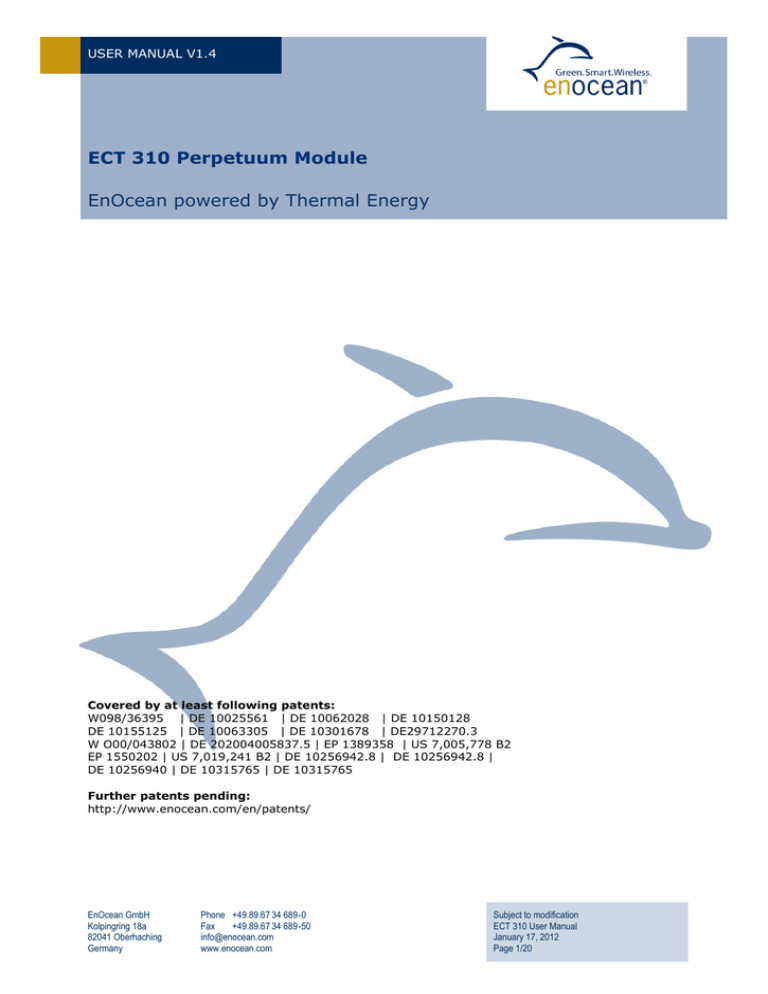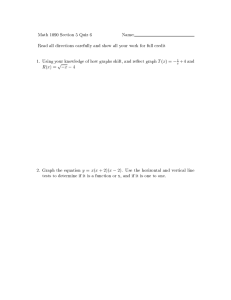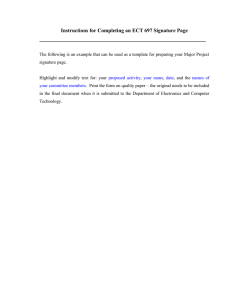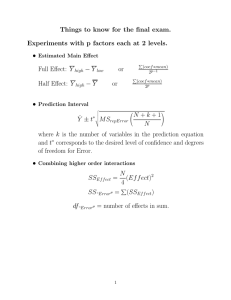
USER MANUAL V1.4
ECT 310 Perpetuum Module
EnOcean powered by Thermal Energy
Covered by at least following patents:
W098/36395 | DE 10025561 | DE 10062028 | DE 10150128
DE 10155125 | DE 10063305 | DE 10301678 | DE29712270.3
W O00/043802 | DE 202004005837.5 | EP 1389358 | US 7,005,778 B2
EP 1550202 | US 7,019,241 B2 | DE 10256942.8 | DE 10256942.8 |
DE 10256940 | DE 10315765 | DE 10315765
Further patents pending:
http://www.enocean.com/en/patents/
EnOcean GmbH
Kolpingring 18a
82041 Oberhaching
Germany
Phone +49.89.67 34 689-0
Fax
+49.89.67 34 689-50
info@enocean.com
www.enocean.com
Subject to modification
ECT 310 User Manual
January 17, 2012
Page 1/20
USER MANUAL
ECT 310 PERPETUUM
REVISION HISTORY
The following major modifications and improvements have been made to the first version of this
document:
No
1.0
1.1
1.2
1.3
1.4
Major Changes
Initial version
Major changes: I/O diagram in Chapter 1.3 added. Physical PCB dimensions changed in
Chapter 1.5 (no side-bulges in series production). Evaluation board connecting corrected in
Chapter 2.5. Chapter 2.6 “Mechanical Integration” extended. Chapter 2.7 “Bipolar Temperature Operation” added.
Attention: Pin marking of series product changed against early samples (Chapters 1.5, 2.7)
Chapter 6 added: APPENDIX – Data Sheet TEC2L-15-15-5.6/73
Additional information regarding anti-parallel use of 2 ECT 310; 2.8 added.
Published by EnOcean GmbH, Kolpingring 18a, 82041 Oberhaching, Germany
www.enocean.com, info@enocean.com, phone +49 (89) 6734 6890
© EnOcean GmbH, All Rights Reserved
Important notes!
A purchase of ECT 310 DC/DC converter module does not include the right to use this component to power other radio interfaces then EnOcean radio (EnOcean patent protection, see
chapter 5).
This information describes the type of component and shall not be considered as assured characteristics. No responsibility is assumed for possible omissions or inaccuracies. Circuitry and specifications
are subject to change without notice. For the latest product specifications, refer to the EnOcean website: http://www.enocean.com.
As far as patents or other rights of third parties are concerned, liability is only assumed for modules,
not for the described applications, processes and circuits.
EnOcean does not assume responsibility for use of modules described and limits its liability to the
replacement of modules determined to be defective due to workmanship. Devices or systems containing RF components must meet the essential requirements of the local legal authorities.
The modules must not be used in any relation with equipment that supports, directly or indirectly,
human health or life or with applications that can result in danger for people, animals or real value.
Components of the modules are considered and should be disposed of as hazardous waste. Local
government regulations are to be observed.
Packing: Please use the recycling operators known to you. By agreement we will take packing material back if it is sorted. You must bear the costs of transport. For packing material that is returned to
us unsorted or that we are not obliged to accept, we shall have to invoice you for any costs incurred.
Observe precautions! Electrostatic sensitive devices!
© 2012 EnOcean | www.enocean.com
ECT 310 User Manual | Page 2/20
USER MANUAL
ECT 310 PERPETUUM
TABLE OF CONTENT
1
GENERAL DESCRIPTION ................................................................................. 4
Basic functionality ......................................................................................... 4
Key Applications ............................................................................................ 4
Technical data ............................................................................................... 5
Physical dimensions ....................................................................................... 6
Pinning......................................................................................................... 6
Environmental conditions ............................................................................... 7
Ordering Information ..................................................................................... 7
Application Information .................................................................................. 8
2.1 Energy Calculation Example ............................................................................ 8
2.2 Thermo powered radio sensors and radio controlled actuators with STM 300 ......... 9
2.3 Powering STM 312 based radio sensors .......................................................... 10
2.4 Evaluation with Development Kit EDK 312 ...................................................... 11
2.5 Evaluation with Development Kit EDK 300 ...................................................... 12
2.5.1 Assembly................................................................................................ 12
2.5.2 Configuration .......................................................................................... 13
2.5.3 Functional check ...................................................................................... 13
2.6 Mechanical integration of Peltier elements ...................................................... 13
2.6.1 Application Example ................................................................................. 14
2.7 Bipolar Temperature Operation ..................................................................... 15
2.8 Multiple Peltier operation .............................................................................. 16
1.1
1.2
1.3
1.4
1.5
1.6
1.7
2
3
4
Assembly ................................................................................................... 16
Connecting the Peltier element ...................................................................... 16
Layout recommendations for foot pattern ....................................................... 17
Soldering information ................................................................................... 18
Packaging Information ................................................................................. 19
Agency Certifications ................................................................................... 19
5
Patent Protection ......................................................................................... 19
6
APPENDIX: Data Sheet TEC2L-15-15-5.6/73 ................................................... 20
3.1
3.2
3.3
3.4
© 2012 EnOcean | www.enocean.com
ECT 310 User Manual | Page 3/20
USER MANUAL
ECT 310 PERPETUUM
1
GENERAL DESCRIPTION
1.1
Basic functionality
ECT 310 is a low-cost ultra-low-voltage DC/DC converter for powering battery-less EnOcean
radio modules by thermal energy. Wireless sensors and even actuators can be operated.
Operation starts at typical 20 mV relating to a 2 Kelvin temperature difference at a standard low-cost Peltier element.
The output power is in the range from µW to mW and depends on the actual temperature
difference at the Peltier element. ECT 310 is designed and optimized for powering EnOcean
radio modules for wireless sensors and actuators. To achieve best generator efficiency the
output voltage is regulated only roughly. The input voltage range of 20 mV to 50 mV corresponds to an output voltage range between 3 V to 4 V.
A typical thermo-driven sensor consists of a sensor element, a small Peltier element, the
ECT 310 DC/DC converter and an EnOcean STM 300 or STM 312 radio module.
Other than STM 300, the STM 312 radio module already has an energy storage on board.
ECT 310 key features
Best in-class Thermo Harvester solution (ultra-low-voltage, high efficiency)
Low-cost DC/DC converter, works with low-cost standard Peltier elements
Designed and optimized for thermo-powered EnOcean wireless applications
SMD footprint
Directly to be soldered onto EnOcean STM 312 wireless sensor transmitter module
Powers STM 300 module to realize bi-directional wireless sensors and actuators
1.2
Key Applications
Wireless Sensors for Building and Industrial automation and Medical (heat cost allocator,
temperature sensor, process control, preventive maintenance, etc.)
Wireless Actuators for Building and Industrial automation (water valves, air flaps, other
mechanical devices)
© 2012 EnOcean | www.enocean.com
ECT 310 User Manual | Page 4/20
USER MANUAL
ECT 310 PERPETUUM
1.3
Technical data
VIN Input voltage start-up
VIN Input voltage max.
VOUT Output voltage @ VIN = 20 .. 50 mV
VOUT Output voltage @ VIN = 20 .. 500 mV
20 mV typ., oc *)
500 mV, oc *)
3 .. 4 V
3 .. 5 V (load < 10 MΩ)
Input source impedance
< 2 Ohm
Efficiency @ 25 mV
30% typ.
*) open circuit: source output voltage without ECT connected
EnOcean's ECT 310 oscillator already starts to resonate upwards of typ. 10 mV open circuit
input voltage. On typ. 20 mV a useful output voltage of more than 3 V is produced. To enable the exceptionally high converter efficiency of 30%, the output voltage is only roughly
regulated to less than 5 V over the entire input voltage range up to 500 mV. This is no
problem for connected EnOcean modules because they are accustomed to working on unregulated supply voltage such as that from solar cells.
© 2012 EnOcean | www.enocean.com
ECT 310 User Manual | Page 5/20
USER MANUAL
ECT 310 PERPETUUM
1.4
Physical dimensions
Module dimensions *)
14 x 14 x 5 mm
Weight
1g
*) PCB edges scratched and cracked, contact pad edges milled and metalized (Au)
1.5
Pinning
Pin
1
2
3
4
Name
Description
VIN
Positive voltage from Peltier element
GND
Ground
GND
Ground
VOUT
Output voltage of the power converter module
Attention! Pin marking has changed from early samples
to volume product. Early samples can be simply identified
by having silver connector pads, volume product has
golden pads (Au).
Early samples pinning:
© 2012 EnOcean | www.enocean.com
ECT 310 User Manual | Page 6/20
USER MANUAL
ECT 310 PERPETUUM
1.6
Environmental conditions
Operating temperature
-20 °C … +60 °C
Storage temperature
-40 °C … +85 °C
Humidity
1.7
0% … 93% r.h., non-condensing
Ordering Information
Type
ECT 310
EDK 312
EDK 312C
Ordering
Code
S3004-P310
S3004-X312
Description
Module
www.enocean.com/de/enocean_module/ect-310perpetuum
Dev Kit 868.3 MHz
www.enocean.com/en/enocean_modules/edk-312
Dev Kit 315.0 MHz
S3034-X312
© 2012 EnOcean | www.enocean.com
ECT 310 User Manual | Page 7/20
USER MANUAL
ECT 310 PERPETUUM
2
2.1
Application Information
Energy Calculation Example
The following diagram shows a typical ECT 310 performance in combination with the Peltier
element TEC2L-15-15-5.6 and the heat sink SK 426. Please note: the output performance
is affected by components connected (largely their thermal resistance) and ambience conditions (e.g. air flow).
The yellow curve is the temperature difference directly on the Peltier element, while the
blue one indicates the difference from the temperature of the surroundings. Seeing as a
heatsink represents a thermal transfer resistance and thus loss of energy, the blue curve is
below the first one. It is possible to read, for example, that even when using a heatsink,
approximately 100 µW of energy is already produced for a temperature difference of only 7
°C. A typical EnOcean wireless module that is waked every two minutes to send a telegram
needs about 5 µW. The remaining 95 µW is enough to power a number of actuators, to
drive water valves, air flaps or other mechanical devices!
Peltier element used:
Type
Temperature coefficient
Internal resistance
Thermal conductivity
© 2012 EnOcean | www.enocean.com
TEC2L-15-15-5.6/73CS (www.eureca.de)
12.5 mV/K
1.44 Ω
0.046 W/K
ECT 310 User Manual | Page 8/20
USER MANUAL
ECT 310 PERPETUUM
Heat sink used:
Type
)Thermal resistance
SK 426, 50 mm (www.FischerElektronik.de)
4.5 K/W
Thermal compound used:
WLP 004 (www.FischerElektronik.de)
2.2
Thermo powered radio sensors and radio controlled actuators
with STM 300
The EnOcean module STM 300 is designed for use in combination with an external energy
harvester and energy storage. This provides high flexibility for the realization of selfpowered sensor and actuator applications.
To support a fast start-up and long term operation with no external energy supply available
two different storages are used typically. A small storage fills quickly and allows a fast
start-up. A large storage fills slowly but once it is filled it provides a large buffer for periods
where no energy is available, e.g. a solar powered sensor at night.
To provide energy quickly and to provide large energy capacity at the same time a small
and a large storage are combined. STM 300 provides a digital output WXODIO which enables to control the charging of these two kind of storages. At the beginning, as long as the
voltage is below the VON voltage only the small storage will be filled. Once the threshold is
reached the WXODIO signal changes and the large storage will be filled. For more details
please see chapter 3.1 of the STM 300 User Manual.
The concept for thermo powered actuators inclusive energy balance calculation is described
in in the article “EVERYTHING THERMO OR WHAT? Actuators without cables and
batteries” in the EnOcean perpetuum magazine, issue 1 from 2009:
www.enocean.com/fileadmin/redaktion/pdf/perpetuum/perpetuum_01_2009_en.pdf
© 2012 EnOcean | www.enocean.com
ECT 310 User Manual | Page 9/20
USER MANUAL
ECT 310 PERPETUUM
Technical details concerning STM 300 power requirement are described in the Application
Note AN#209 “STM 300 Thermo or Battery Powered” from EnOcean:
www.enocean.com/de/application-notes
2.3
Powering STM 312 based radio sensors
The EnOcean module STM 312 is a module designed for use with an external energy harvester; however, in comparison to the STM 300 the energy storage is integrated already
on-board. As well a whip or a helix antenna is pre-installed already. In addition the ECT 310
can be soldered directly onto the STM 312 module.
All together this enables very compact designs with lowest development effort. For more
information refer to the STM 31x User Manual, please.
What is important is that the energy supply is fully isolated from the sensor circuitry. In other words powering is by temperature but entirely different process
variables can be measured such as pressure or humidity.
© 2012 EnOcean | www.enocean.com
ECT 310 User Manual | Page 10/20
USER MANUAL
ECT 310 PERPETUUM
2.4
Evaluation with Development Kit EDK 312
For speedy evaluation of a thermally powered sensor, the ECT 310 can be simply soldered
to the back of the STM 312. All components needed are contained in the EnOcean EDK 312
evaluation kit:
EDK 312 consists of following parts:
868 MHz STM 312 all-in-one wireless sensor module with integrated energy storage
ECT 310 ultra-low-voltage DC/DC converter
Peltier element TEC2L-15-15-15-5.6
Programming Adapter Board EVA 330
Detailed documentation
EDK 312C consists of following parts:
315 MHz STM 312C all-in-one wireless sensor module with integrated energy storage
Others same as EDK 312
The ECT 310 can be soldered directly onto the STM 312 module. For more details consult
the STM 31x User Manual.
Given the high efficiency of the system (already works at a temperature difference of 2 °K),
simply placing a finger on one of the ceramic wafers of the Peltier element will cause the
wireless sensor to transmit. The opposite ceramic wafer must of course contact a somewhat
cooler surface.
© 2012 EnOcean | www.enocean.com
ECT 310 User Manual | Page 11/20
USER MANUAL
ECT 310 PERPETUUM
2.5
Evaluation with Development Kit EDK 300
For evaluation of an ECT 310 in combination with a STM 300 the multi purpose EnOcean
Dev Kit EDK 300 can be used. The first steps are described in the following.
2.5.1 Assembly
Connect the Peltier element to the ECT 310 module pads VIN+ and VIN- (for pinning
see chapter 1.5, for connecting please urgently note chapter 3.1).
Connect the ECT 310 pads Vout and GND to the External Source input of the EVA
320 board (see the following figure).
Voltmeter
ECT
310
© 2012 EnOcean | www.enocean.com
Peltier
ECT 310 User Manual | Page 12/20
USER MANUAL
ECT 310 PERPETUUM
2.5.2 Configuration
Configure the EVA 320 board according to the following application example:
-
Temperature sensor: NTC on ADIO0
Retransmit: every
Wakeup: 1s
Long term storage: EXT. (None)
Source: EXT. SOLAR (Peltier connected)
Power Management: Off (On board)
If the heat sink has room temperature (e.g. 20 °C) and one finger (e.g. 30 °C) is pressed
onto the Peltier element above, the element will generate a few mV. Please verify the right
polarity. ECT 310 will transform the generated voltage to a higher voltage and load the
short term capacitor on the EVA 320 board. The STM 300 module on the board will be powered by this energy and start sending telegrams.
2.5.3 Functional check
Check the ECT 310 output voltage via voltmeter. To monitor the ramp up of the ECT 310
output voltage it can be measured at VDD and GND. The long term storage is not connected in this example. Anyway loading the short term storage will last some seconds until
supply voltage is high enough for the STM 300 to send telegrams.
2.6
Mechanical integration of Peltier elements
Peltier elements can be used as thermo-electrical generators. A temperature difference between the two plates of a Peltier element generates electrical power, e.g. to drive electronic
circuits. Low-cost Peltier elements provide at small temperature differences an output voltage of a few mV only. Therefore this ultra low-voltage DC/DC converter is required to
boost the small output voltages to a voltage > 3 V as required for standard electronic circuits. With a start-up voltage of 20 mV the ECT 310 is currently the best component inclass.
The next figure illustrates typical integration of such a Peltier element. The efficiency of
energy generation depends on the thermal transfer resistance between the hot and cold
sides of the Peltier element. It is consequently necessary to ensure good thermal insulation
of the two ceramic wafers, for instance by using suitable plastic or styrofoam.
Please note the following:
Use thermal compound. The compound must be temperature resistant, should be
attached carefully and take care that the layer of compound is thin, homogeneous
and contains no air bubbles.
In use of a heat sink for natural convection it should be noted that the effective
thermal resistance depends on heat sink geometry and the heat flow of surrounded
air.
© 2012 EnOcean | www.enocean.com
ECT 310 User Manual | Page 13/20
USER MANUAL
ECT 310 PERPETUUM
The efficiency of the Peltier element increases with the temperature difference dT =
Thot - Tcold
Ensure good thermal decoupling of the hot and the cold Peltier plates!
Avoid thermal short circuiting of the mechanical assembly, e.g. by using Styrofoam or Polystyrene for heat decoupling.
The low start up temperature and the considerable size of a low-cost Peltier element (e.g.
TEC2L from Eureca measuring 15 x 15 x 5.6 mm) should allow low skill and effort for
mechanical integration to achieve reasonable performance. The size of the plates (e.g. 15 x
15 mm) should allow sufficient thermal contact to both, the hot and to the cold material.
The thickness of the Peltier element (e.g. 5.6 mm) makes it considerable to mount
insulating material of suitable thickness (e.g. styrofoam or use simply the plastic wall of a
casement box).
So for typical sensor applications the selection of a suited Peltier element and its
mechanical system integration should not be critical. If optimum in performance is
needed, e.g. for actuators with relatively high energy demand, please consult an experienced manufacturer of Peltier elements to help you to select and qualify the best elements
and accessories for your individual application.
2.6.1 Application Example
As an example for the mechanical integration of a Peltier element please find the picture of
a prototype of a thermo powered air-duct temperature sensor in the following. The inside is
brought up to air flow temperature through a thin copper film, a heatsink on the outside
creates a difference in temperature from the second ceramic plate. The air flow tempera-
© 2012 EnOcean | www.enocean.com
ECT 310 User Manual | Page 14/20
USER MANUAL
ECT 310 PERPETUUM
ture inside the tube thus causes the Peltier voltage to power the sensor. The air flow temperature inside the tube thus causes the Peltier voltage to power the sensor.
2.7
Bipolar Temperature Operation
The ECT 310 is unipolar so it is important to ensure correct polarity of the Peltier element.
If both cold and hot temperatures are to be used, two ECT 310 modules can be connected
to the Peltier element in antiparallel circuit.
ECT310 is equipped with a reverse diode at the input. If two ECT310 are connected antiparallel at the input to serve either positive or negative thermo-voltage, one of these diodes will always be conductive. Due to their forward voltage of 0.7V, the leakage current
can be neglected in normal operation voltage range, which is only 20mV up to 200mV.
© 2012 EnOcean | www.enocean.com
ECT 310 User Manual | Page 15/20
USER MANUAL
ECT 310 PERPETUUM
2.8
Multiple Peltier operation
If multiple energy harvesters shall be used, several ECT 310 may be connected in parallel
at the output Vout and GND, while each input is served by one Peltier element.
T1
1
2,3
ECT
310
4
Vout
T2
T1
1
2,3
T2
ECT
310
4
GND
3
3.1
Assembly
Connecting the Peltier element
Take care for low transfer and contact resistance (shortest cable and lines, sufficient diameter, good cable soldering). Please note the correlation between mV and
mΩ: Due to the high transformation rate (e.g. 20 mV to 3.5 V = factor 175) the
input current will increase to rather high values. Therefore a resistance of a few
mΩ at the contact or the line will already lead to a massive performance loss!
The length of lines should not exceed 5 cm!
Lines of 5 cm or longer may act as distortive antennas for the connected radio
module.
© 2012 EnOcean | www.enocean.com
ECT 310 User Manual | Page 16/20
USER MANUAL
ECT 310 PERPETUUM
3.2
Layout recommendations for foot pattern
The length of lines connected to I/Os should not exceed 5 cm.
Lines of 5 cm or longer may act as distortive antennas for the connected radio
module.
A GND layer below the module is recommended strongly.
At the backside of the module are several test pads.
It is important to exclude the possibility of short circuiting to the main PCB, e.g.
by using suited solder resist on the main board.
© 2012 EnOcean | www.enocean.com
ECT 310 User Manual | Page 17/20
USER MANUAL
ECT 310 PERPETUUM
3.3
Soldering information
The ECT 310 module has to be soldered according to IPC/JEDEC J-STD-020C standard.
ECT 310 may be soldered only once, since one time is already consumed at production of the module itself.
ECT 310 modules have to be soldered within 6 months after delivery!
© 2012 EnOcean | www.enocean.com
ECT 310 User Manual | Page 18/20
USER MANUAL
ECT 310 PERPETUUM
3.4
Packaging Information
For automatic assembly the ECT 310 modules are available in a pick & place tray. The outer
dimensions of the tray are 166 x 205 mm. Drawings showing further details of the tray will
be provided by EnOcean upon request. The standard ECT 310 packaging unit is a card box
that contains 100 ECT modules in 5 trays with 20 modules each and one empty cover tray
(100 pcs = 5 x 20 pcs).
4
Agency Certifications
The ECT 310 module assembly conforms to the European and national requirements of
electromagnetic compatibility (EMC).
The CE conformity is proven; the relevant documentation is on file at EnOcean.
5
Patent Protection
EnOcean GmbH owns multiple patents in the area of self-powered applications. An overview can be
found at following link: http://www.enocean.com/en/patents/ .
Thermo-powered wireless is covered by at least the following patents:
http://www.patent-de.com/20030227/DE10137504A1.html
http://www.patent-de.com/20071129/DE102006024167A1.html
Patent pending for ECT 310
A purchase of ECT 310 DC/DC converter module does not include the right to use this component to
power other radio interfaces then EnOcean radio.
© 2012 EnOcean | www.enocean.com
ECT 310 User Manual | Page 19/20
USER MANUAL
ECT 310 PERPETUUM
6
APPENDIX: Data Sheet TEC2L-15-15-5.6/73
© 2012 EnOcean | www.enocean.com
ECT 310 User Manual | Page 20/20






